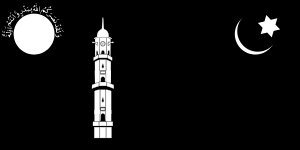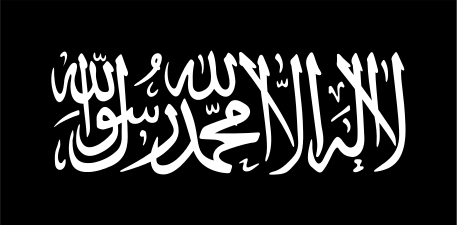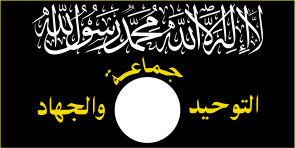Black Standard
.svg.png)
The Black Banner or Black Standard (Arabic: راية السوداء rāyat as-sawdāʾ, also known as راية العقاب rāyat al-ʿuqāb "banner of the eagle" or simply as الراية ar-rāya "the banner") is one of the flags flown by Muhammad in Islamic tradition. It was historically used by Abu Muslim in his uprising leading to the pro-Shia Abbasid Revolution in 747 and is therefore associated with the Abbasid Caliphate in particular. It is also a symbol in Islamic eschatology (heralding the advent of the Mahdi).[1]
The Black Banner has been used in contemporary Islamism and jihadism since the late 1990s.[2]
Origin
Before Islam, visible standards were used at least in the Roman army to identify the core of the legion, the Eagles. By the mid-600s, the Arabs were using standards for the same purpose. Among the Arabs the rāya was a square banner; not to be confused with the liwāʾ or ʿalam, an identifying mark like a red turban.[3][4]
Islamic tradition states that the Quraysh had a black liwāʾ and a white-and-black rāya.[5] It further states that Muhammad had an ʿalam in white nicknamed "the Young Eagle" (العقاب al-ʿuqāb); and a rāya in black, said to be made from his wife Aisha's head-cloth.[6] This larger flag was known as the Eagle.[7]
The hadith reports Muhammad said that the advent of the Mahdi would be signaled by Black Standards proceeding from Khorasan and that it will be the flag of the army that will fight the Masih ad-Dajjal.[8][9][10]
At the Battle of Siffin, according to tradition, Ali used the liwāʾ of the Prophet, which was white[3][4] while those who fought against him instead used black banners.[11]
Historical use
The Abbasid Revolution against the Umayyad Caliphate adopted black for its rāyaʾ for which their partisans were called the musawwids.[12] Their rivals chose other colours in reaction; among these, forces loyal to Marwan II adopted red.[13] The choice of black as the colour of the Abbasid Revolution was already motivated by the "black standards out of Khorasan" tradition associated with the Mahdi. The contrast of white vs. black as the Fatimid vs. Abbasid dynastic colour over time developed in white as the colour of Shia Islam and black as the colour of Sunni Islam.[14]
After the revolution, Islamic apocalyptic circles admitted that the Abbasid banners would be black but asserted that the Mahdi's standard would be black and larger.[8][9][10] Anti-Abbasid circles cursed "the black banners from the East", "first and last".[15]
A black flag was used by the Hotak dynasty in the early 18th century, following Mirwais Hotak's Sunni rebellion against the Twelver Shi'i Safavid dynasty and later by the Emirate of Afghanistan under Abdur Rahman Khan (1880–1901).
The Bábí leader Mullá Husayn raised the Black Standard in his westward march from Mashhad starting July 21, 1848, to proclaim the Báb's message. It is reported the Black Standard flew above the Bábí fortress Shaykh Tabarsi.[16] As Arab nationalism developed in the early 20th century, the black within the Pan-Arab colors was chosen to represent the black banner of Muhammad.

The Ahmadiyya movement also employs black and white colours in its flag (Liwaa-i Ahmadiyya), first hoisted in 1939.[18] Mirza Tahir Ahmad, the fourth caliph of the Ahmadiyya Caliphate, explained the symbolism of the colours black and white in terms of the concept of revelation and prophethood.[19]
Jihadist black flag


The Pashtun tradition of using a black flag with a white shahada (Islamic creed) inscription as a military ensign, harking back to the 18th-century Hotak dynasty, was adopted by the Taliban, and thence by Al-Qaeda in the 1990s. This usage was adopted by the global jihadism movement in the early 2000s, and in the 2010s by the Islamic State of Iraq and the Levant.[20][21][22]
A black flag with the shahada inscribed in white appeared on jihadist websites from at least 2001. (Reported on Flags of the World by Santiago Tazon on 17 November 2001: "I have found in several 'hard Islamic' websites the symbol of a white Taliban flag crossed with its inverted colour version (probably identified as Al‑Qaeda flag): black background with shahada in white. I do not know if this flag is recognised by Al‑Qaeda; but it is normally flying in pro-Al-Qaeda sites.")[23]
Even though the historical black banner did not have any inscription, this variant is commonly known as al-rāya (the banner) or as rayat al-ʻuqab (banner of the eagle) after the hadith tradition, and some western observers have dubbed it the black flag of jihad.[24][25] Islamic extremist organizations which have used such a black flag include:
- al-Qaeda
- al-Shabaab
- the Islamic Courts Union
- the Islamic State of Iraq and the Levant (ISIL/ISIS/IS)
- Hizbul Islam (2009)
In the last decade of the South Thailand insurgency, the al-Raya' flag has largely replaced the colourful secessionist flags formerly used by the different groups involved in violent actions against the government of Thailand.[26][27]

The variant used by the Islamic State of Iraq and the Levant, and before that by Al-Shabaab (since c. 2006) depicts the second phrase of the shahada in the form of a depiction of the supposedly historical seal of Muhammad.[28] The white circle represents the seal, enclosing the three words, الله رسول محمد (allāh[i] rasūl[u] muḥammad[un] "Muhammad is the prophet of God"). Note that this word order is different from the second part of the conventional form of the shahada, ''muḥammad[un] rasūl[u] allāh[i] .
In August 2014, British Prime Minister David Cameron suggested that anybody displaying "the Islamic State flag" in the United Kingdom should be arrested.[29]
It has also been banned from a public demonstration in the Netherlands in August 2014.[30]
The use of the image or the ISIL/ISIS/IS flag (but not other versions of the black standard) for non-educational purposes has been forbidden in Germany by the Federal Ministry of the Interior since September 2014.[31] Neighbouring Austria proposed a ban in the same month.[32]
See also
References
- ↑ David Cook (2002). Studies in Muslim Apocalyptic. Darwin Press. p. 197. from Majlisi,
- ↑ David Wroe; James Massola (December 16, 2014). "Flag being held by Lindt Chocolat Cafe hostages is not an Islamic State flag". The Sydney Morning Herald. Retrieved 2015-03-03.
the black banner which was used in the 1990s
- 1 2 Hinds 1996, p. 97-142.
- 1 2 Hinds 1996, p. 104-6.
- ↑ Hinds 1996, p. 133.
- ↑ Nicolle 1993, p. 6.
- ↑ Hinds 1996, p. 108.
- 1 2 Cook 2002, p. 153.
- 1 2 Cook 2002, p. 125.
- 1 2 Cook 2002, p. 206.
- ↑ Hinds 1996, p. 109.
- ↑ Tabari (1995), Jane McAuliffe, ed., Abbāsid Authority Affirmed, 28, SUNY, p. 124
- ↑ Patricia Crone (2012). The Nativist Prophets of Early Islam. p. 122.. As remembered in pro-Umayyad apocalyptic: page 125}
- ↑ "The proselytes of the ʿAbbasid revolution took full advantage of the eschatological expectations raised by black banners in their campaign to undermine the Umayyad dynasty from within. Even after the ʿAbbasids had triumphed over the Umayyads in 750, they continued to deploy black as their dynastic colour; not only the banners but the headdresses and garments of the ʿAbbasid caliphs were black [...] The ubiquitous black created a striking contrast with the banners and dynastic color of the Umayyads, which had been white [...] The Ismaili Shiʿite counter-caliphate founded by the Fatimids took white as its dynastic color, creating a visual contrast to the ʿAbbasid enemy [...] white became the Shiʿite color, in deliberate opposition to the black of the ʿAbbasid 'establishment'." Jane Hathaway, A Tale of Two Factions: Myth, Memory, and Identity in Ottoman Egypt and Yemen, 2012, p. 97f.
- ↑ Patricia Crone (2012). The Nativist Prophets of Early Islam. p. 243.
- ↑ Smith, Peter (2000). A Concise Encyclopedia of the Bahá'í Faith. Oneworld Publications, (Sales and Editorial), 185 Banbury Road, Oxford, OX2 7AR. ISBN 1-85168-184-1.
- ↑ The writing above the image of the full moon is a part of the Quranic verse 124 of Sura Aal Imran (English translation: "And Allah had (already) helped you at Badr, when you were a contemptible little force.")
- ↑ "A Brief History of Ahmadiyya Movement In Islam". Alislam.org. 1939-12-28. Retrieved 2016-03-23.
- ↑ "Question: Why do Muslims use black flags if the color black is associated with death and mourning?". Askislam.org. 1984-10-22. Retrieved 2016-03-23. "Black absorbs total light, [it] does not emit an iota of light, so from looking heavenly-wards black indicates that we absorb entire light from heaven, and white reflects total light without being dishonest about it, so a Messenger has two aspects. One of receiving things from Allah, in that respect he's nabi [prophet], whatever he receives he completely, totally absorbs, and when he speaks to the others he reflects the entire light without being dishonest or stingy about it, so that reflection makes it white. So reception that is a complete reception without leaving anything out and reflection that is a complete reflection without leaving anything out, they are witnessed only in two colours: black and white. So both have been employed in Islam as flags." "Archived copy". Archived from the original on 2015-06-30. Retrieved 2015-06-27.
- ↑ "Very interestingly, the Taliban hail from the Pashtun ethnicity and have traditionally used two flags, a white flag with a black Shahada (Kalma) embossed for their government and diplomatic purposes and a reversal of this i.e. a black flag with a white Shahada embossed for their military. These types of black flags are also vividly seen across the tribal Pashtun areas that are now reportedly under the control of Pakistani Taliban." Bilal Khan, Black Banners From Khurasan: The Bilad-e-Khurasan in Making, 2008 (grandstrategy.com)
- ↑ "Usama bin Ladin often signed his name with the location, 'Khurasan, Afghanistan' at the end of his messages whilst a guest of the Taliban. His organisation, Al-Qa’ida, also specifically adopted black flags from the 1990s. Reading between the lines, it is obvious that Bin Ladin saw Al-Qa’ida as fulfilling a sacred prophecy, bringing armies led by black flags towards Damascus and Jerusalem, in preparation for the coming of the messianic figure, the Mahdi." (The Black Flags of Khurasan)
- ↑ "ISIS - Flag - Check123, Video Encyclopedia". Check123 - Video Encyclopedia. Retrieved 2016-09-20.
- ↑ "Flag of the Islamic Khilafah".
- ↑ The Economist, Extremist ideology: Jail, jihad and exploding kittens, 2014-11-01
- ↑ For example:
Perlmutter, Dawn (2014-08-19). "Black Flag in Jersey: A Jihadist Identifier Camouflaged". Frontpage Mag. frontpagemag.com. Retrieved 2014-12-15.
[...] an obvious terrorist identifier, the ‘Black Flag of Jihad’, has been successfully camouflaged as a benign symbol of faith, protected in the media by political correctness and Muslim apologetics.
- ↑ "Neojihadism and YouTube: Patani militant propaganda dissemination and radicalization" (PDF). Retrieved 2016-03-23.
- ↑ "Bomb blast in Pattani misses Aree".
- ↑ The SITE (Search for International Terrorist Entities) website on 23 January 2007 stated: "The Islamic State of Iraq issued a document titled: 'The Legality of the Flag in Islam,' which contains the image of its flag and information to its symbolism, today, Tuesday, January 23, 2007. Text on the flag reading, 'No God, but Allah, and Muhammad is Allah’s Messenger,' are the words contained on the flag of the Prophet Muhammad that he carried into battle and handed to generations of bearers. The Islamic State provides evidence and legitimacy for this banner from Islamic scholars, and goes into detail regarding opinions of the flag’s material, title, and significance. According to the group the circular shape matches the ring stamp of the Prophet found on many scripts, and the order of the words are to indicate the supremacy of Allah over the Messenger." Cited by Ivan Sache at Flags of the World on 18 February 2007.
- ↑ "Iraq crisis: Cameron warns of possible IS threat to UK". BBC News. 16 August 2014. Retrieved 17 August 2014.
- ↑ Cluskey, Peter (2 August 2014). "Dutch ban display of Isis flag in advance Amsterdam march". Irish Times. Retrieved 19 November 2014.
- ↑ Eddy, Melissa (12 September 2014). "Germany Bans Support for ISIS". The New York Times. Retrieved 19 November 2014.
- ↑ "Austria bans Isis terror symbols". The Local. 12 September 2014. Retrieved 19 November 2014.
Works cited
- Cook, David (2002). Studies in Muslim Apocalyptic. Darwin Press. ISBN 978-0-87850-142-7.
- Hinds, Martin (1996). Studies in Early Islamic History. Darwin Press. ISBN 978-0-87850-109-0.
- Nicolle, David (1993). Armies of the Muslim Conquest. Osprey Publishing. ISBN 978-1-85532-279-0.
External links
| Wikimedia Commons has media related to Jihadist flags. |
- Collection of imagery of black flags used in Islamic extremism
- The Black Flag (al-raya) at The Islamic Imagery Project, The Combating Terrorism Center at West Point
- The Semiotics of a Black Flag (makingsenseofjihad.com)
- Usama Hasan, The Black Flags of Khurasan (unity1.wordpress.com)
- Muslim extremist rally disrupting Remembrance Day in London (November 2010)